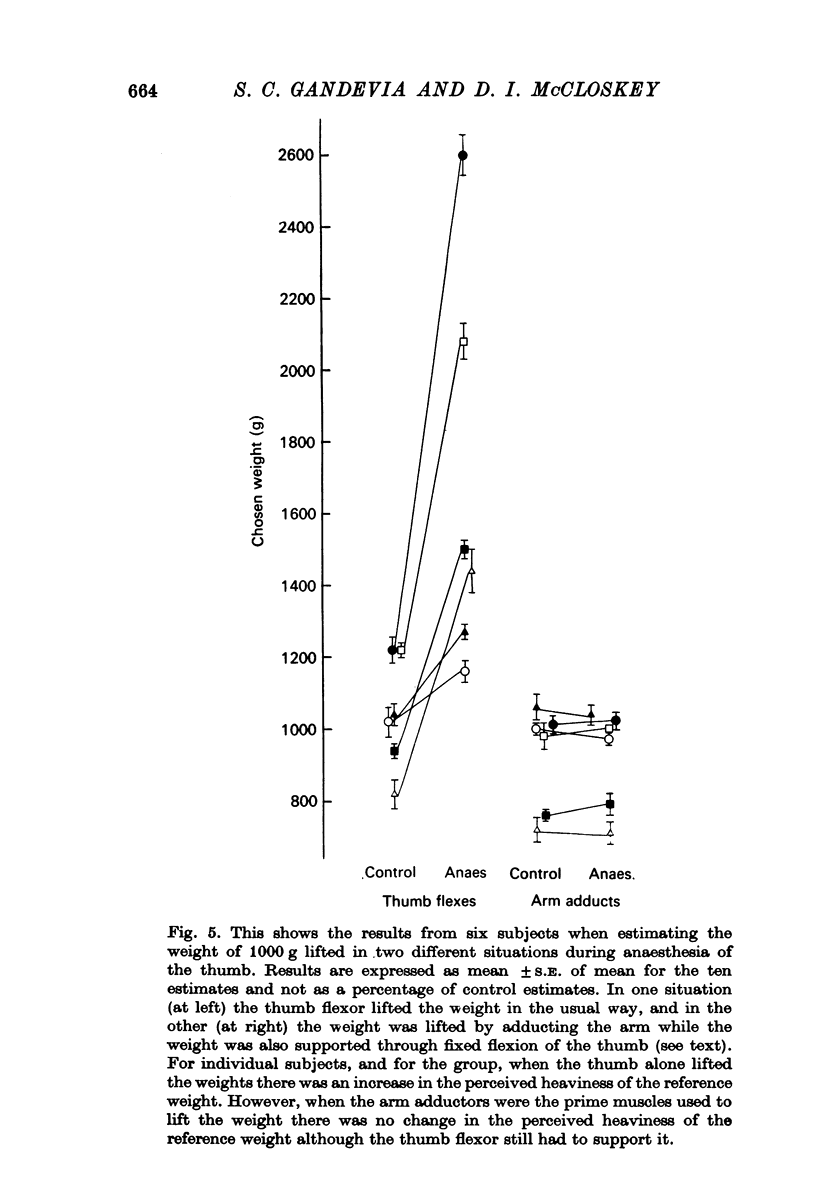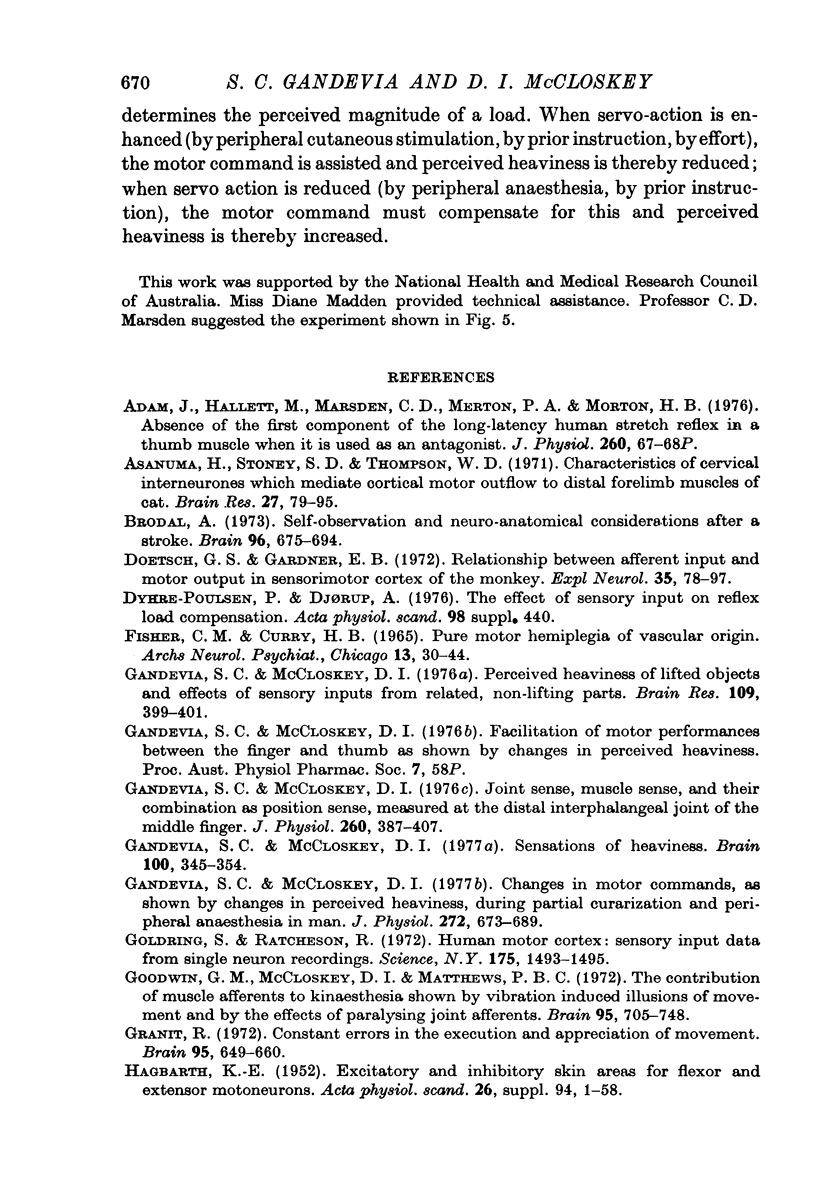Abstract
1. The perception of the heaviness of lifted objects was studied using a weight-matching task when sensory inputs from parts related to the lifting task were altered.
2. A weight lifted by flexing the index finger feels heavier when the thumb is anaesthetized and lighter when the thumb is electrically stimulated. A weight lifted by flexing the distal joint of the thumb feels heavier when the sensory input from the skin and joint of the thumb is abolished by anaesthesia. It also feels heavier when the index (but not the little) finger is anaesthetized, and lighter when the index (but not the little) finger is electrically stimulated.
3. A weight lifted by extending the thumb feels lighter when the sensory input from the thumb is abolished.
4. The perceived heaviness of a weight lifted by flexing the thumb is increased during anaesthesia of the thumb when the flexor of the thumb is the prime mover but not when it is acting simply as a postural fixator to support the weight.
5. The sensation of the heaviness of lifted objects derives from the effort or centrally generated voluntary motor command employed in the lift. Our results indicate that the motor commands to either thumb or index finger flexors are facilitated by sensory inputs arising from a wide sensory field usually involved in co-operative motor performances carried out by both muscle groups together.
Full text
PDF



















Selected References
These references are in PubMed. This may not be the complete list of references from this article.
- Adam J., Hallett M., Marsden C. D., Merton P. A., Morton H. B. Absence of the first component of the long-latency human stretch reflex in a thumb muscle when it is used as an antagonist [proceedings]. J Physiol. 1976 Sep;260(2):67P–68P. [PubMed] [Google Scholar]
- Asanuma H., Stoney S. D., Jr, Thompson W. D. Characteristics of cervical interneurones which mediate cortical motor outflow to distal forelimb muscles of cats. Brain Res. 1971 Mar 19;27(1):79–95. doi: 10.1016/0006-8993(71)90373-8. [DOI] [PubMed] [Google Scholar]
- Brodal A. Self-observations and neuro-anatomical considerations after a stroke. Brain. 1973 Dec;96(4):675–694. doi: 10.1093/brain/96.4.675. [DOI] [PubMed] [Google Scholar]
- Davis J. N., Sears T. A. The proprioceptive reflex control of the intercostal muscles during their voluntary activation. J Physiol. 1970 Aug;209(3):711–738. doi: 10.1113/jphysiol.1970.sp009188. [DOI] [PMC free article] [PubMed] [Google Scholar]
- Doetsch G. S., Gardner E. B. Relationship between afferent input and motor output in sensorimotor cortex of the monkey. Exp Neurol. 1972 Apr;35(1):78–97. doi: 10.1016/0014-4886(72)90061-1. [DOI] [PubMed] [Google Scholar]
- FISHER C. M., CURRY H. B. PURE MOTOR HEMIPLEGIA OF VASCULAR ORIGIN. Arch Neurol. 1965 Jul;13:30–44. doi: 10.1001/archneur.1965.00470010034005. [DOI] [PubMed] [Google Scholar]
- Gandevia S. C., McCloskey D. I. Changes in motor commands, as shown by changes in perceived heaviness, during partial curarization and peripheral anaesthesia in man. J Physiol. 1977 Nov;272(3):673–689. doi: 10.1113/jphysiol.1977.sp012066. [DOI] [PMC free article] [PubMed] [Google Scholar]
- Gandevia S. C., McCloskey D. I. Joint sense, muscle sense, and their combination as position sense, measured at the distal interphalangeal joint of the middle finger. J Physiol. 1976 Sep;260(2):387–407. doi: 10.1113/jphysiol.1976.sp011521. [DOI] [PMC free article] [PubMed] [Google Scholar]
- Gandevia S. C., McCloskey D. I. Perceived heaviness of lifted objects and effects of sensory inputs from related, non-lifting parts. Brain Res. 1976 Jun 11;109(2):399–401. doi: 10.1016/0006-8993(76)90542-4. [DOI] [PubMed] [Google Scholar]
- Gandevia S. C., McCloskey D. I. Sensations of heaviness. Brain. 1977 Jun;100(2):345–354. doi: 10.1093/brain/100.2.345. [DOI] [PubMed] [Google Scholar]
- Goldring S., Ratcheson R. Human motor cortex: sensory input data from single neuron recordings. Science. 1972 Mar 31;175(4029):1493–1495. doi: 10.1126/science.175.4029.1493. [DOI] [PubMed] [Google Scholar]
- Goodwin G. M., McCloskey D. I., Matthews P. B. The contribution of muscle afferents to kinaesthesia shown by vibration induced illusions of movement and by the effects of paralysing joint afferents. Brain. 1972;95(4):705–748. doi: 10.1093/brain/95.4.705. [DOI] [PubMed] [Google Scholar]
- HAGBARTH K. E. Excitatory and inhibitory skin areas for flexor and extensor motoneurons. Acta Physiol Scand Suppl. 1952;26(94):1–58. [PubMed] [Google Scholar]
- Heath C. J., Hore J., Phillips C. G. Inputs from low threshold muscle and cutaneous afferents of hand and forearm to areas 3a and 3b of baboon's cerebral cortex. J Physiol. 1976 May;257(1):199–227. doi: 10.1113/jphysiol.1976.sp011364. [DOI] [PMC free article] [PubMed] [Google Scholar]
- LIDDELL E. G. T., PHILLIPS C. G. Overlapping areas in the motor cortex of the baboon. J Physiol. 1951 Feb;112(3-4):392–399. doi: 10.1113/jphysiol.1951.sp004536. [DOI] [PMC free article] [PubMed] [Google Scholar]
- LIDDELL E. G. T., PHILLIPS C. G. Thresholds of cortical representation. Brain. 1950 Jun;73(2):125–140. doi: 10.1093/brain/73.2.125. [DOI] [PubMed] [Google Scholar]
- LUNDBERG A., NORRSELL U., VOORHOEVE P. Pyramidal effects on lumbo-sacral interneurones activated by somatic afferents. Acta Physiol Scand. 1962 Nov-Dec;56:220–229. doi: 10.1111/j.1748-1716.1962.tb02497.x. [DOI] [PubMed] [Google Scholar]
- Lawrence D. G., Kuypers H. G. The functional organization of the motor system in the monkey. I. The effects of bilateral pyramidal lesions. Brain. 1968 Mar;91(1):1–14. doi: 10.1093/brain/91.1.1. [DOI] [PubMed] [Google Scholar]
- Lund J. P., Lamarre Y. The importance of positive feedback from periodontal pressoreceptors during voluntary isometric contraction of jaw-closing muscles in man. J Biol Buccale. 1973 Dec;1(4):345–351. [PubMed] [Google Scholar]
- Lundberg A., Malmgren K., Schomburg E. D. Convergence from Lb, cutaneous and joint afferents in reflex pathways to motoneurones. Brain Res. 1975 Apr 4;87(1):81–84. doi: 10.1016/0006-8993(75)90783-0. [DOI] [PubMed] [Google Scholar]
- Marsden C. D., Merton P. A., Morton H. B. Behaviour of short and long latency components of the stretch reflex in human muscle. J Physiol. 1975 Mar;246(2):43P–44P. [PMC free article] [PubMed] [Google Scholar]
- Marsden C. D., Merton P. A., Morton H. B. Is the human stretch reflex cortical rather than spinal? Lancet. 1973 Apr 7;1(7806):759–761. doi: 10.1016/s0140-6736(73)92141-7. [DOI] [PubMed] [Google Scholar]
- Marsden C. D., Merton P. A., Morton H. B. Servo action and stretch reflex in human muscle and its apparent dependence on peripheral sensation. J Physiol. 1971 Jul;216(1):21P–22P. [PubMed] [Google Scholar]
- Marsden C. D., Merton P. A., Morton H. B. Servo action in human posture [proceedings]. J Physiol. 1976 Dec;263(1):187P–188P. [PubMed] [Google Scholar]
- Marsden C. D., Merton P. A., Morton H. B. Servo action in the human thumb. J Physiol. 1976 May;257(1):1–44. doi: 10.1113/jphysiol.1976.sp011354. [DOI] [PMC free article] [PubMed] [Google Scholar]
- McCloskey D. I., Ebeling P., Goodwin G. M. Estimation of weights and tensions and apparent involvement of a "sense of effort". Exp Neurol. 1974 Jan;42(1):220–232. doi: 10.1016/0014-4886(74)90019-3. [DOI] [PubMed] [Google Scholar]
- Rosén I., Asanuma H. Peripheral afferent inputs to the forelimb area of the monkey motor cortex: input-output relations. Exp Brain Res. 1972;14(3):257–273. doi: 10.1007/BF00816162. [DOI] [PubMed] [Google Scholar]
- Wiesendanger M. Input from muscle and cutaneous nerves of the hand and forearm to neurones of the precentral gyrus of baboons and monkeys. J Physiol. 1973 Jan;228(1):203–219. doi: 10.1113/jphysiol.1973.sp010082. [DOI] [PMC free article] [PubMed] [Google Scholar]


